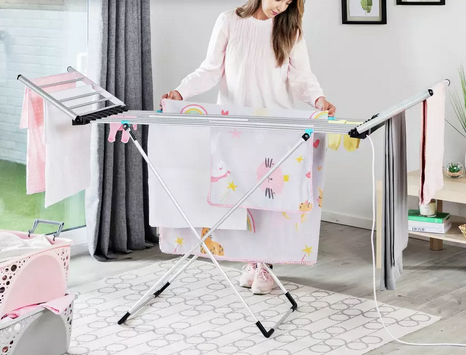
When it comes to drying clothes indoors, especially in the colder months, many people find themselves torn between two popular contenders: heated airers and dehumidifiers. Both alternatives offer a more cost-effective and energy-efficient solution to the traditional Tumble Dryer. So with a lower cost option in mind and if you’re tired of soggy radiators and that never-ending damp laundry smell. Both options can make drying clothes indoors quicker and more efficient. But which one is best suited for your home?
Heated Airer: The Warmth-Friendly Wonder
A heated airer is essentially a modern clothes horse with built-in heating elements. Just plug it in, and it provides gentle warmth that helps clothes dry faster. Heated airers come in various sizes and styles, with foldable and multi-level options to suit everything from compact flats to family-sized loads.
Pros of Heated Airers:
- Energy Efficiency - Heated airers generally use far less energy than a tumble dryer. They offer a warm, direct heat to clothes without needing to heat the whole room, which keeps energy costs lower.
- Quick Drying - While not as instant as a tumble dryer, heated airers dry clothes much faster than leaving them on a regular airer. Thicker items like jeans or jumpers can dry in a few hours rather than an entire day.
- Space-Saving Design - Many heated airers are foldable, allowing easy storage when not in use. Some models even come with covers to retain heat and speed up drying.
- Warm Laundry Bonus - There’s nothing like the feeling of warm clothes on a chilly morning. With a heated airer, you get that added warmth which can be a cozy touch in winter!
Cons of Heated Airers
- Not Ideal for Humid Homes – Heated airers don’t reduce moisture in the air, which can be a problem if you’re drying multiple loads or live in a humid home.
- Small Load Capacity – Most heated airers work best with a lighter load, which can be limiting if you have a large family’s laundry to manage.
- Initial Cost – While not as pricey as some appliances, heated airers do require an upfront cost that might make some hesitate, especially for the larger, high-quality models.
View the full range of Heated Airers here
Dehumidifier: The Damp-Busting Dynamo
A dehumidifier removes excess moisture from the air, which is fantastic for drying clothes while keeping your home damp-free. Many models now have dedicated “laundry modes” for tackling wet clothes, making them increasingly popular for drying laundry indoors.
Pros of Dehumidifiers
- Moisture Control – Dehumidifiers actively draw out moisture from the air, making them ideal for anyone dealing with a naturally damp or humid environment. They help prevent condensation and mold, which is great for your walls and health.
- Efficient Drying for Larger Loads – By reducing moisture in the room, dehumidifiers help dry all your laundry in one go, regardless of how much is on the rack. Plus, you can combine them with a regular drying rack or even a heated airer for a supercharged drying process.
- Year-Round Use – Beyond drying clothes, a dehumidifier helps regulate the air quality in your home. This can be useful if you experience dampness or humidity, particularly in basements or poorly ventilated spaces.
- Low Noise Levels – Dehumidifiers generally operate quietly, so you can have one running without the hum of a tumble dryer disturbing the peace.
Cons of Dehumidifiers
- Running Costs – Dehumidifiers do use electricity, and depending on the model, they might consume more energy than a heated airer. It’s worth checking the energy efficiency of a model before buying.
- Limited Warmth – While dehumidifiers do help dry clothes, they don’t provide warmth directly to your laundry, so the clothes may not feel toasty-warm like they would on a heated airer.
- Initial Expense – Good quality dehumidifiers can be a bit pricey upfront. While many consider them a long-term investment for indoor air quality, the initial cost may be a factor.
View the full range of Dehumidifiers here
Which Should You Choose?
If you’re choosing between a heated airer and a dehumidifier, think about your home environment, budget, and laundry needs. Here’s a quick summary to help you make the best choice:
Choose a Heated Airer If: You want an affordable, energy-efficient way to dry smaller loads of laundry, appreciate a bit of warmth, and don’t mind the occasional bit of moisture in the air. Heated airers are great for smaller spaces where dampness isn’t an issue.
Choose a Dehumidifier If: Your home struggles with damp or condensation, you have a lot of laundry to dry, or you’re concerned about mold. A dehumidifier will help with drying while also improving the air quality, making it ideal for those who want a dual-purpose device.
When looking at overall running costs there isn’t much to choose from with averages for both types of dryers coming in at 5p – 20p per hour. A lot of factors depend on the size and capacity of models.
The Verdict: Can They Work Together?
In fact, many people swear by using both a heated airer and a dehumidifier together! With a heated airer warming the clothes and a dehumidifier drawing moisture from the air, you get the best of both worlds: fast drying and a dry home. Plus, using them together can actually reduce running times, which saves energy and speeds up drying.
So, which side are you on in the battle to beat the damp? Whether it’s a cozy heated airer or a powerful dehumidifier, you’re well on your way to warm, dry clothes even on the dreariest days!